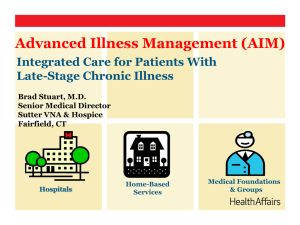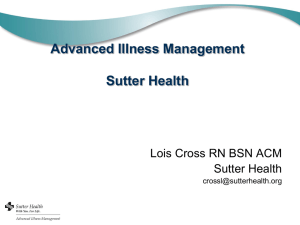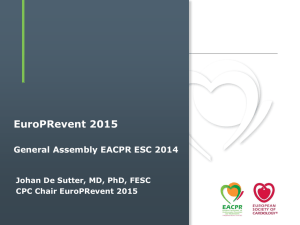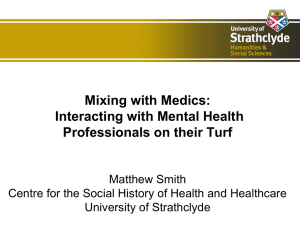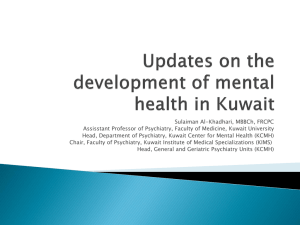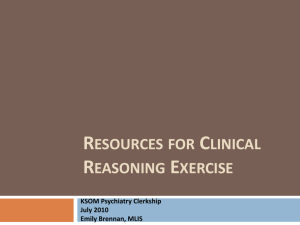Sutter Health Sutter Center for Psychiatry 2013
advertisement
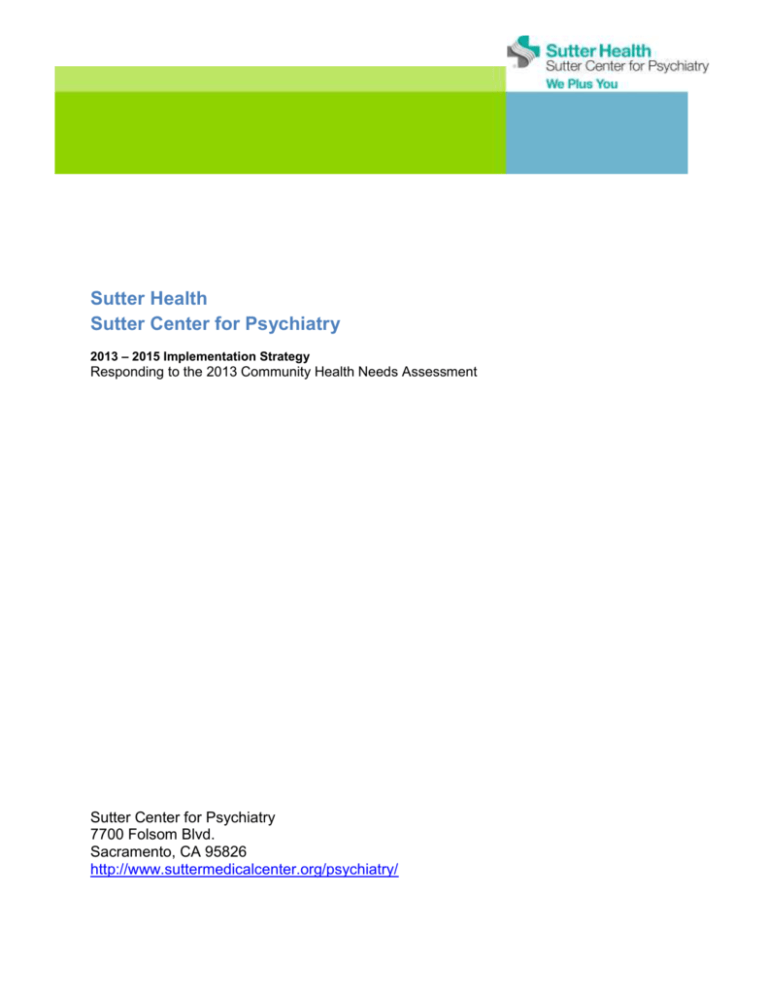
Sutter Health Sutter Center for Psychiatry 2013 – 2015 Implementation Strategy Responding to the 2013 Community Health Needs Assessment Sutter Center for Psychiatry 7700 Folsom Blvd. Sacramento, CA 95826 http://www.suttermedicalcenter.org/psychiatry/ Table of Contents Introduction ........................................................................................................................ 3 About Sutter Health ........................................................................................................... 3 2013 Community Health Needs Assessment Summary .................................................. 4 Definition of Community Served by the Hospital ....................................................... 4 Significant Health Needs Identified ........................................................................... 5 2013 – 2015 Implementation Strategy ............................................................................... 8 Lack of access to primary and preventative services/Lack of access to mental health services .................................................................................................................... 9 Lack of Housing/Basic Shelter ................................................................................ 13 Needs Sutter Center for Psychiatry Plans Not to Address ........................................... 15 Approval by Governing Board ........................................................................................ 16 2 Sutter Center for Psychiatry, Implementation Strategy 2013 - 2015 Introduction This implementation strategy describes how Sutter Center for Psychiatry, a Sutter Health affiliate, plans to address significant needs identified in the Community Health Needs Assessment (CHNA) published by the hospital on December 1, 2013. The document describes how the hospital plans to address identified needs in calendar (tax) years 2013 through 2015. The 2013 CHNA and this implementation strategy were undertaken by the hospital to understand and address community health needs, and in accordance with proposed Internal Revenue Service (IRS) regulations pursuant to the Patient Protection and Affordable Care Act of 2010. This implementation strategy addresses the significant community health needs described in the CHNA that the hospital plans to address in whole or in part. The hospital reserves the right to amend this implementation strategy as circumstances warrant. For example, certain needs may become more pronounced and merit enhancements to the described strategic initiatives. Alternately, other organizations in the community may decide to address certain community health needs, and the hospital may amend its strategies and refocus on other identified significant health needs. Beyond the initiatives and programs described herein, the hospital is addressing some of these needs simply by providing health care to the community, regardless of ability to pay. About Sutter Health Sutter Center for Psychiatry is affiliated with Sutter Health, a not-for-profit network of hospitals, physicians, employees and volunteers who care for more than 100 Northern California towns and cities. Together, we’re creating a more integrated, seamless and affordable approach to caring for patients. The hospital’s mission is to enhance the health and well-being of people in the communities we serve, through a not-for-profit commitment to compassion and excellence in health care services. Vision Sutter Health leads the transformation of health care to achieve the highest levels of quality, access and affordability. Values Excellence and Quality Caring and Compassion Honesty and Integrity Teamwork Community At Sutter Health, we believe there should be no barriers to receiving top-quality medical care. We strive to provide access to excellent health care services for Northern Californians, regardless of ability to pay. As part of our not-for-profit mission, Sutter Health invests millions of dollars back into the communities we serve – and beyond. Through these investments and community partnerships, we’re providing and preserving vital programs and services, thereby improving the health and well-being of the communities we serve. In 2012, our network of physician organizations, hospitals and other health care providers invested $795 million (compared to $756 million in 2011) in health care services for low-income people, community health improvement services, and other community benefits. For more facts and information about Sutter Center for Psychiatry, please visit http://www.suttermedicalcenter.org/psychiatry/ 3 Sutter Center for Psychiatry, Implementation Strategy 2013 - 2015 2013 Community Health Needs Assessment Summary Every three years nonprofit hospitals are required to conduct community health needs assessments (CHNA) and use the results of these to develop community health improvement implementation plans. These requirements are imposed on virtually all nonprofit hospitals by both state and federal laws. Beginning in early 2012 through February 2013, Valley Vision, Inc. conducted an assessment of the health needs of residents living in the service area of Sutter Center for Psychiatry (SCP). For the purposes of the assessment, a health need was defined as: “a poor health outcome and its associated driver.” A health driver was defined as: “a behavioral, environmental, and/or clinical factor, as well as more upstream social economic factors, that impact health.” The objective of the CHNA was to provide necessary information for the Sutter Center for Psychiatry’s community health improvement plan, identify communities and specific groups within these communities experiencing health disparities, especially as these disparities relate to chronic disease, and further identify contributing factors that create both barriers and opportunities for these populations to live healthier lives. The full 2013 Community Health Needs Assessment report conducted by Sutter Center for Psychiatry is available at http://www.sutterhealth.org/communitybenefit/community-needs-assessment.html Definition of Community Served by the Hospital The complete CHNA report for Sutter Medical Center, Sacramento covered the Health Service Areas (HSA) of Sutter General Hospital, Sutter Memorial Hospital, and Sutter Center for Psychiatry. A key focus was to show specific communities (defined geographically) experiencing disparities as they related to chronic disease and mental health. To this end, ZIP code boundaries were selected as the unit-of-analysis for most indicators. This level of analysis allowed for examination of health outcomes at the community level that are often hidden when data are aggregated at the county level. Some indicators (demographic, behavioral, and environmental in nature) were included in the assessment at the census tract, census block, or point prevalence level, which allowed for deeper community level examination. The HSA was determined by analyzing patient discharge data from two of the three facilities that make up SMCS. Collection and analysis of the ZIP codes of patients discharged from the hospitals over a six-month period allowed the primary geographic area served by the hospitals to be identified. The HSA identified as the focus of the needs assessment is depicted in Figure 2 in the final CHNA. Because the hospitals represented in SMCS (Sutter General Hospital, Sutter Memorial Hospital, and Sutter Center for Psychiatry) are close in proximity, analysis revealed that the hospitals served the same geographic areas. To identify Communities of Concern, input from the CHNA team, primary data from key informant interviews and focus groups, along with detailed analysis of secondary data, health outcome indicators, and sociodemographics were examined. ZIP code communities with rates that consistently exceeded county, state, or Healthy People 2020 benchmarks for ED utilization, hospitalization, and mortality were considered. ZIP codes with rates that consistently fell in the top 20% were noted and then triangulated with primary data input and sociodemographic data to identify specific Communities of Concern. 4 Sutter Center for Psychiatry, Implementation Strategy 2013 - 2015 Data on socio-demographics of residents in these communities, which included socio-economic status, race and ethnicity, educational attainment, housing arrangement, employment status, and health insurance status, were examined. Area health needs were determined via in-depth analysis of qualitative and quantitative data, and then confirmed with socio-demographic data. As noted earlier, a health need was defined as a poor health outcome and its associated driver. A health need was included as a priority if it was represented by rates worse than the established quantitative benchmarks or was consistently mentioned in the qualitative data. Figure 5 in the full report depicts the ZIP code boundaries for the Communities of Concern for the SMCS HSA. The Communities of Concern are home to more than 200,000 residents. The areas consist of ZIP code communities occupying the northern, downtown, and southern portions of the Sacramento County area. All of the ZIP code communities are densely populated, with the South Sacramento area having the highest population and the downtown area having the lowest population. Socio-demographic conditions, or social determinants of health, help predict which communities in a broad geographic area are most susceptible to poor health outcomes. In general, the vast majority of residents living in the Communities of Concern fell into multiple categories of social determinants often associated with poor health outcomes. For example, all ZIP code communities far exceeded the national benchmarks for the percent of families in a living in poverty with children and single-female headed households with children living in poverty. All communities had high percentages of non-White or Hispanic residents, with 84% in 95823 and 83% in 95824 falling into this category. Further, all Communities of Concern had high percentages of residents without health insurance compared to state and national benchmarks. Significant Health Needs Identified The following significant health needs were identified by the 2013 CHNA. Significant Community Health Need Lack of access to primary and preventative services Lack of adequate County (Sacramento) safety net/health network for low income residents; Lack of chronic disease management programs; No appointments available in low cost/free clinics; Recent job losses resulting in loss of income and benefits; Navigating the complex system of social services; and Discrimination by physician towards low income/Medi-Cal insured populations 5 Intends to Address Yes Sutter Center for Psychiatry, Implementation Strategy 2013 - 2015 Significant Community Health Need Lack of access to mental health services Inadequate mental health services; Stigmas in seeing mental health services; Difficulty navigating the system for public assistance to receive mental health services; Reduction in services offered by County; and Finding private practice counselors that take Medi-Cal Living in an unhealthy food environment Improper nutrition; Limited access to healthy foods; Difficulty in passing healthy nutrition policies; Children’s reliance on reduced price meals at school; Lack of food/nutrition education; Fewer stores carrying fresh foods in low income neighborhoods and cost of healthier foods; and Food insecurity Intends to Address Yes No Perceived or real fear for personal safety Gang violence, Fear of walking on busy streets and Fear of violence in public places, i.e., parks No Inability to exercise and be active Built environment impedes (limited sidewalks, dangerous street); Fear for personal safety limits outdoor activities in high crime areas; Suburbs built for reliance on automobile; Costs of joining gym; and Costs to participate in sports for kids is prohibitive No Lack of access to dental care Limited access to dental care – all forms of oral health Yes Lack of access to specialty care Limited specialists that accept Medi-Cal patients No Lack of coordination of care among providers Lack of chronic disease management and care transition programs; Patient receiving care from multiple providers working independently of one another Yes Acculturation/limited cultural competence in health and related systems Lack of cultural competence among healthcare providers; Racism and related stress caused; Over reliance on prescriptions by “western” doctors; and Suspicion of “western” medicine, reluctance to get vaccines, etc. No Lack of health literacy Not understanding the dangers of tobacco use; and Cultural norms that support poor health behaviors (tobacco) No Lack of housing, basic shelter Housing instability and Fear of losing home Yes Age-adjusted rates of ED visits and hospitalization due to heart disease, diabetes, stroke, and hypertension were notably higher in communities of concern when compared to others within the HSA. With a few exceptions, Blacks and Whites had the highest rates for these conditions compared to other racial and ethnic groups. Mortality data for these conditions showed high rates as well. Analysis of environmental indicators showed that many of these communities had barriers to active lifestyles, such as elevated crime rates and a traffic climate that is unfriendly to bicyclists and pedestrians. Furthermore, 6 Sutter Center for Psychiatry, Implementation Strategy 2013 - 2015 these communities frequently had higher percentages of residents that were obese or overweight. Access to healthy food outlets was limited, while the concentration of fast food outlets and convenience stores were high. Analysis of the health behaviors of these residents also showed many behaviors that correlate to poor health, such as having a diet that is limited in fruit and vegetable consumption. When examining these findings with those of the qualitative data (key informant interview and focus groups), a consolidated list of priority health needs of these communities was compiled, listed above. 7 Sutter Center for Psychiatry, Implementation Strategy 2013 - 2015 2013 – 2015 Implementation Strategy This implementation strategy describes how Sutter Center for Psychiatry plans to address significant health needs identified in its 2013 Community Health Needs Assessment and consistent with its charitable mission. The strategy describes: Actions the hospital intends to take, including programs and resources it plans to commit; Anticipated impacts of these actions and a plan to evaluate impact; and Any planned collaboration between the hospital and other organizations. 8 Sutter Center for Psychiatry, Implementation Strategy 2013 - 2015 Lack of access to primary and preventative services/Lack of access to mental health services Name of Program, Initiative or Activity Interim Care Program (ICP) and ICP Plus Description The Interim Care Program (ICP) and ICP Plus helps Sutter Center for Psychiatry fulfill its mission to provide access to care for vulnerable and traditionally underserved residents. A collaborative of the four health care systems, community based organizations and the county government came together in Sacramento to create a respite care shelter for homeless patients discharged from hospitals, establishing an 18-bed shelter for homeless men and women to recuperate from medical conditions. Started in 2004, the Interim Care Program links people in need to vital community services while giving them a place to heal. The clients who are enrolled in the ICP are homeless adult individuals who otherwise would be discharged to the street or cared for in an inpatient setting only. The program is designed to offer clients up to six weeks during which they can focus on recovery and developing a plan for their housing and care upon discharge. This innovative community partnership provides temporary respite housing in Sacramento that offer homeless men and women a place to recuperate from their medical conditions, link them to vital community services, and provide them a place to heal. ICP Plus is a program designed for homeless patients discharging from SMCS, and is an enhanced version of the ICP, with patients needing a greater level of support and special resources. SMCS and the other health systems provide financial support for this program. WellSpace Health, Sacramento’s Federally Qualified Health Center, provides on-site nursing and social services to support clients in their recuperation and help them move out of homelessness. The WellSpace case manager links clients with mental health services, substance abuse recovery, housing workshops and provides disability application assistance. The Salvation Army provides 18 beds in a designated wing of the shelter where clients have three meals a day and a safe, clean place to recover from their hospitalizations. Anticipated Impact and Plan to Evaluate ICP and ICP+ have consistently demonstrated that they improve access to care and mental health services for uninsured, medically indigent people residing in the community. We will continue to evaluate the impact of these programs on a quarterly basis, by tracking the number of people served, number of linkages to other referrals/services and other indicators, and by assessing the community’s access to care needs in its next Community Health Needs Assessment. In addition to addressing the lack of access to primary and preventative services, the ICP and ICP+ also tackle lack of access to mental health services, lack of coordination of care among providers and lack of housing/basic shelter. 9 Sutter Center for Psychiatry, Implementation Strategy 2013 - 2015 Name of Program, Initiative or Activity Triage, Transport and Treat Description Sutter Medical Center, Sacramento is a founding partner of T3, a program launched in 2006 that provides services to patients who seek emergency department care for needs that are best addressed through preventive measures and by primary care providers. This program is a model for the kind of change being called for in various health care reform plans. A huge obstacle for healthcare providers, including Sutter Medical Center, Sacramento, is the inappropriate use of the Emergency Department. This issue is not only problematic for the healthcare provider, but also for the patients who are not receiving the appropriate care in the appropriate place, at the appropriate time. Programs like T3 seek to connect people who frequently and inappropriately use the Emergency Department to the correct resources, including housing and mental health services, which is key to the population who utilizes T3. Moving these patients from the emergency department improves the patients’ health by providing them with the appropriate care in the right setting, while reducing the wait for those seeking care for real medical emergencies, and dramatically reducing costs to our health care system. SMCS partners with and provides funding to WellSpace Health, the Sacramento region’s largest Federally Qualified Health Clinic, to offer this program to some of the most vulnerable patients in our service area. Anticipated Impact and Plan to Evaluate The T3 program has proven to be effective in improving access to care and mental health services for uninsured, medically indigent people residing in the community. We will continue to evaluate the impact of T3 quarterly, by tracking the number of people served, recidivism rates, number of linkages to other referrals/ services and other indicators, and by assessing the community’s access to care needs in its next Community Health Needs Assessment. In addition to addressing the lack of access to primary and preventative services, the T3 program also addresses lack of access to mental health services, lack of coordination of care among providers and lack of housing/basic shelter. Name of Program, Initiative or Activity Investment in WellSpace Health Description As we prepare for the implementation of the Affordable Care Act, we understand that nothing is more important than expanding access to care and building capacity for the underserved. Currently, limited access to care remains the top priority in the Sacramento region, and while SMCS funds and supports many initiatives and organizations that do 10 Sutter Center for Psychiatry, Implementation Strategy 2013 - 2015 amazing work in our community, the investments we provide to WellSpace to expand capacity remain paramount. SMCS has been a longtime partner with WellSpace Health and will continue to make strategic investments and provide support to this critically important network, as WellSpace expands throughout the greater Sacramento Region. WellSpace provides care to some of the most vulnerable populations in our region. By continuing to invest in this important health center, we are ensuring the underserved have access to care and a medical home. Established in 1953, WellSpace is a Federally Qualified Health Center (FQHC) offering primary care, pediatric dental care and specialty and integrated behavioral health services. The Sacramento-based non-profit has earned a strong reputation locally that has been built on providing quality, innovative, reliable and affordable healthcare. WellSpace has six full service health centers in Oak Park, North Highlands, midtown Sacramento, Roseville, South Sacramento and now Rancho Cordova, 8 part-time satellites and three pending full scope health centers. WellSpace also operates a wide array of prevention and intervention programs throughout the region. WellSpace Health is also a leader in integrated care, blending physical health services with addiction and mental health treatment, and has a “No Wrong Door” belief. This means that each service site seeks to connect community members to everything WellSpace Health has to offer. WellSpace offers the following services to the underserved population in the greater Sacramento region: Adult & Geriatric, Pediatrics, Dental Care, Women’s Health, Birth and Family Health, Prenatal Care, Immunizations, Mental Health & Counseling, Suicide Prevention, Child Abuse Prevention, Psychiatry, Addictions Counseling and serves as a partner to all of the health systems in our region, as well as many nonprofit and community based organizations. By investing in WellSpace and supporting this tremendous organization’s growth and innovative efforts, we are able to address multiple priority needs in effective and impactful ways. While investing in WellSpace addresses the lack of access to primary and preventative services, lack of access to dental care and lack of access to specialty care, WellSpace is a leader in providing behavioral and mental health care services to the underserved in the SCP HSA. Anticipated Impact and Plan to Evaluate 11 We work closely with the staff and leadership of WellSpace to measure the impact of this important FQHC’s work. The WellSpace programs and expansion efforts have proven to expand access to care for the underinsured, medically indigent people residing in the greater Sacramento community. We will continue evaluate the impact of WellSpace, by tracking the number of people served, number of linkages Sutter Center for Psychiatry, Implementation Strategy 2013 - 2015 to other referrals and services and other indicators, and by assessing the community’s access to care needs in its next Community Health Needs Assessment. 12 Sutter Center for Psychiatry, Implementation Strategy 2013 - 2015 Lack of Housing/Basic Shelter Name of Program, Initiative or Activity Serial Inebriate Program (SIP) Description The Serial Inebriate Program (SIP) is a result of a partnership between Sutter Medical Center, Sacramento and the Downtown Sacramento Partnership (DSP) Navigators. Using a model with great success, the DSP Navigators reach out and build a one-on-one rapport with homeless adults living on downtown streets. The Navigators gradually develop relationships and eventually connect individuals with local community service programs. The Navigators don’t move on at that point; they continue working closely with each individual, facilitating access to care and finding ways to improve their living conditions. Another SIP partner is the Sacramento district attorney’s office and the downtown community prosecutor, which both work with SIP patients and homeless adults who have been arrested repeatedly for public intoxication. Though other cities are beginning to offer similar programs, the Sacramento programs offer a unique twist. The SIP unites downtown and midtown Sacramento businesses, nonprofit organizations, government, enforcement agencies and Sutter Medical Center, Sacramento in a truly collaborative effort. For many years, homelessness seemed to be an eternal, incurable epidemic. In recent years, however, the connection between homeless and hopeless has begun to give way. The shift has come about through an innovative idea that is appearing in a growing number of cities, including Sacramento. The approach offers chronically homeless adults an important ingredient missing in past programs—the opportunity to move into permanent housing and medical homes. To qualify, individuals have been arrested, taken to detox centers or emergency departments more than 25 times in a 12-month period. The program consists of a partnership between Sutter Medical Center, Sacramento, Sacramento’s Navigator program (sponsored by the Downtown Partnership, an organization that supports the business community), and Sacramento Self Help Housing. The goal of the SIP is to move homeless men and women off the streets, and connect them with the medical services and housing resources they wouldn’t otherwise have access to. The SIP program provides early intervention and a lasting solution, by linking the homeless to housing, primary care, substance abuse resources and mental health services. Instead of relying on police or other non-profit agencies that work to alleviate homelessness and the problems associated with it, the SIP is a partnership that helps break the cycle and help these men and women move off the streets and on with their lives. In addition to addressing the lack of housing/basic shelter, the SIP provides access to primary and preventative services, lack of access to mental health services, lack of access to dental care and lack of health literacy by teaching the SIP clients how to cook, 13 Sutter Center for Psychiatry, Implementation Strategy 2013 - 2015 about nutrition, going to doctors’ appointments and living an overall healthier life. Anticipated Impact and Plan to Evaluate 14 SMCS recently won the Jackson Health Care Award (a National Award) for the innovative Serial Inebriate Program. Despite this recent success, we continually evaluate the effectiveness of this program, by examining number of people served, number of people connected with long term housing and other indicators. Sutter Center for Psychiatry, Implementation Strategy 2013 - 2015 Needs Sutter Center for Psychiatry Plans Not to Address No hospital can address all of the health needs present in its community. Sutter Center for Psychiatry is committed to serving the community by adhering to its mission, using its skills and capabilities, and remaining a strong organization so that it can continue to provide a wide range of community benefits. This implementation strategy does not include specific plans to address the following significant health needs that were identified in the 2013 Community Health Needs Assessment: Living in an unhealthy food environment: Not only is there a lack of effective interventions to address this need, this is not something that we are able to greatly affect through community benefit; therefore, we are focusing our resources elsewhere. Perceived or real fear for personal safety: This is primarily a law enforcement issue and not something that SCP has the expertise to effectively address. Inability to exercise and be active: Exercise is very important, but surrounding health systems like Kaiser have a comprehensive exercise program, which allows us to dedicate our resources to meeting other needs outlined in the CHNA. Lack of access to specialty care: While this is something that neighboring Sutter Medical Center, Sacramento is working to address, this is not a priority issue for Sutter Center for Psychiatry. Acculturation/limited cultural competence in health and related systems: While we work hard to partner with culturally sensitive/competent staff members and attempt to meet the needs of diverse groups through our sponsorship and community investment award funding, this is not a key priority as this time, as the need is not as pressing as other problems. Lack of health literacy: While this is important, this need is not as our primary focus, which is expanding access to care and building the capacity we so desperately need in the Sacramento Region. 15 Sutter Center for Psychiatry, Implementation Strategy 2013 - 2015 Approval by Governing Board This implementation strategy was approved by the Governing Board of Sutter Center for Psychiatry on November 11, 2013. 16 Sutter Center for Psychiatry, Implementation Strategy 2013 - 2015


